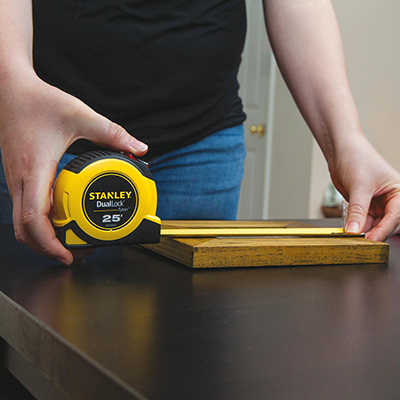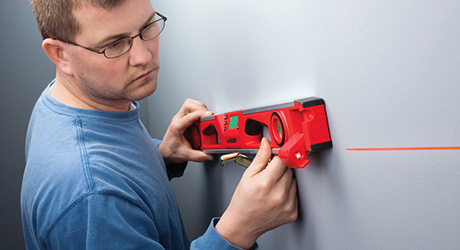Best Square for DIY

Published April 7, 2025
Most DIY building projects start with a square, even when the goal is to end up with a circle. A square is a layout tool that is used with a tape measure, protractor, level and pencil to mark materials for building.
The best square depends on the project. This guide will help you determine which square, or squares, you should add to your DIY toolkit.
Table of Contents
Rafter Square
Trim Square
Universal Square
Framing Square
Combination Square
Try Square
Rafter Square

Rafter squares are best for framing roofs, just like the name implies, but they’ve earned a permanent place in many tool belts. Carpenters like that this tool functions as a square, protractor, saw guide, line scribe, shim, and miter gauge. The most common size for a rafter is 7 inches, but 4-1/2 and 12 inch models are available as well. Rafter squares are manufactured from several materials, but most are made with aluminum or plastic. Different models will have various features, but most are covered in this basic list.
- Square
- Notches to scribe lines
- 45 degree miter
- Protractor
- Rafter gauges for normal and hip roofs
These tools have a simple, tough design that belies their multitude of features.
Some of the various features from different manufacturers are:
- Extendable straightedge for marking longer lines
- Cutouts in the body for marking lines at common distances like 1-1/2 inches
- Markings, notches or holes at common measurements like 3-1/2 or 5-1/2 inches
- Pivot notch for plumb bob
- Bubble level
- Bottle opener
Trim Square

Using the same triangular form as a rafter square and incorporating some of the same features like scribing notches and a protractor, a trim square is simpler and smaller.
- It’s intended for use by trim carpenters.
- Its length is 4-1/2 inches.
- The heel heights are 1/4 inch and 3/8 inch, as those are common measurements used when trimming windows and doors.
- It fits easily into tool belts due to its small size.
Universal Square

Similar to the rafter square is the universal square. It performs many of the same functions, but has features such as a tape hook slot, chalk line hook and a foot designed to help align 2x material.
Many of its features are designed for laying out framing for buildings on concrete foundations, but it’s also useful for DIY projects.
Framing Square

Framing squares come in several sizes, but the most common one has a leg that is 2 feet long.
- These tools are useful as a simple square, but the markings and tables allow them to be used to lay out framing for many aspects of a building, from the foundation to the roof.
- Framing squares are usually made of steel or aluminum. They have a wealth of information, by way of tables and charts, printed right on the faces of the square.
- They are easily adapted to mark stair stringers by adding stair gauges.
- When measuring with a framing square, be sure to verify the scale markings. Some of the gradations are marked in tenths (1/10) or twelfths (1/12) rather than the eighths (1/8) or sixteenths (1/16) we are accustomed to on standard measuring tapes. Twelfths are useful for measuring scale drawings and tenths are known as an engineer’s scale.
Combination Square

Combination squares are versatile tools where the head slides on a ruler.
- They come in many sizes, but the most common are 6, 12, and 16 inches.
- The most common materials of construction are an aluminum head and a stainless steel ruler; however, some use cast iron for the head.
- The sliding head often incorporates a metal scribe that screws into a storage hole and a bubble level.
- A combination square is useful for measuring depth by placing the head on a surface, sliding the ruler to the depth being measured, then measuring the length of the ruler that is projecting.
- It’s easy to make repeated markings by setting the ruler to a length, then using that length to measure.
- There is also a 45 degree angle for marking miters.
Try Square

A try square is used more often in the workshop rather than the job site.
- The shorter leg is often heavier and thicker than the longer leg. It can be placed on a work surface and stand on its own. This is useful for squaring a table saw blade to the table or to square the fence of a jointer. It’s good for checking the square of an item that stands on its own.
- It can be used as a reference to help drill a hole that is 90 degrees to the surface.
- It’s often used to check corners of wood for squareness when milling wood for fine woodworking projects, like furniture.
- Some try squares incorporate a 45 degree bevel.
- A machinist’s square is similar to the try square, but smaller. They are most often used in metal work, but are useful in woodworking as well.
Drywall or T Square

A drywall, or “T” square, can be used with any sheet, like plywood or MDF.
- The long leg is 48 inches long, the same as the width of a sheet of drywall.
- It’s useful for drawing long, straight lines across a sheet while only having to mark one measurement.
- It can also be used as a guide for cutting with a utility knife. Drywall is often cut by making a scoring cut on the finished paper side, then striking the back of the sheet behind the line, causing it to snap cleanly. The remaining backing paper is then bent and cut with the utility knife.
- T-squares are available in fixed and adjustable versions. The adjustable model is easier to store and can be used to find angles. Choose the best square for your particular project.
The best square for your project will make your work better and easier. Most DIYers will find that they need several types to cover every job.
Need a new square? Use The Home Depot Mobile App to find the right one for you.































